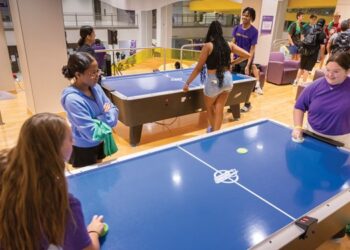But there was one problem: DePaul didn’t believe it could implement the plan on its own. The university needed help running the new 123,000-square-foot facility and turned to B&D, which at the time wasn’t set up to operate a recreation center.
“We believed we could do it, but we knew it would require building a team of the highest quality of collegiate recreation professionals, who were also the right fit for DePaul,” said Paul Brailsford, a principal and co-founder of B&D and CENTERS, LLC. “B&D was not set up to operate a recreation center, so the CENTERS partnership was born.”
As the first management company to exclusively serve and support collegiate recreation, CENTERS started with the DePaul project in 1998 and sits under the B&D umbrella. Over the past 21 years, it has grown to manage 10 university and college campuses, and employ 100-plus full-time staff members and 3,000 part-time student workers. Facility size ranges from 60,000 to 152,000 square feet, and sites are both public and private.
Jeff Sessine, the senior vice president of CENTERS, said the first few years of the company were fast-paced. “We were trying to establish and stabilize the DePaul operation, while developing company-wide policies for student development and customer service. Together, we developed the blueprint for an operational framework that encourages entrepreneurial and innovative thinking within the traditional infrastructure of higher education.”
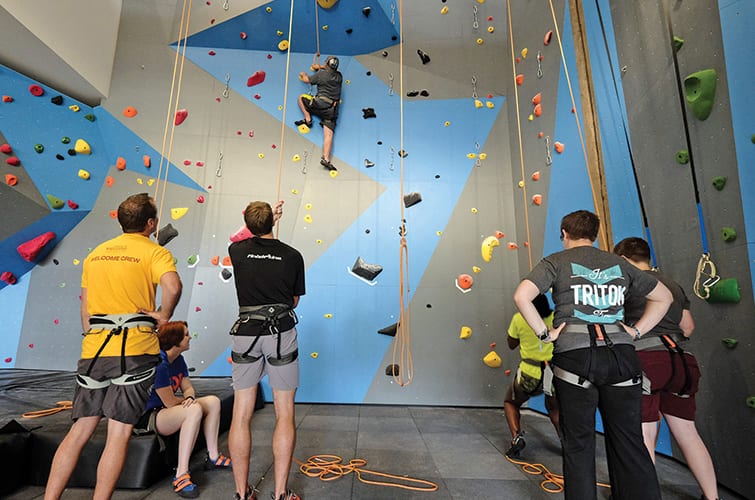
They were also developing a unique organizational culture. “Although the Ray Meyer Fitness & Recreation Center would have to reflect a full integration into DePaul’s campus culture, and every other facility CENTERS operated would have to do likewise on its campus, a common culture of high performance would have to cut across all of the sites for us to build a company that maintained a consistent brand and expectations our clients could count on,” said Chris Dunlavey, a principal and co-founder of B&D and CENTERS.
This idea of a common culture is at the root of CENTERS’ success. Both founders believe in its power to make or break a rec department and its mission. “If you have had the opportunity to walk through a range of campus recreation centers, you know its culture is more important than the architecture, and the culture is set by the professional staff,” said Brailsford.
Vocabulary is what communicates this common culture across 10 different sites — namely the motto, “Better is better,” to distinguish the high-performance culture CENTERS has created.
“To be surrounded by ambitious professionals like themselves is one of the primary reasons our employees share when asked why they were interested in joining the CENTERS community of campus recreation professionals,” said Sessine. “This culture, our mantra ‘Better is better,’ is sustainable because of the shared focus on our purpose, mission and vision.”
But of course, culture is nothing without those who live it day to day. Sessine said the most important thing CENTERS does is emphasize the person over the position. “Most importantly, we want to make sure we have the right people committed to working on our team and that these people are in the positions best suited for us to exceed the goals set forth within our campus partnership,” he said.
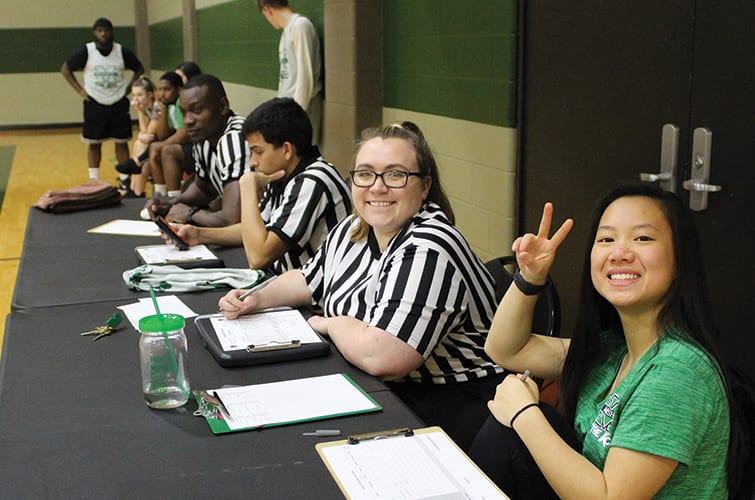
CENTERS looks to develop its staff into entrepreneurs — as in, someone who knows how to create value through the lens of the department’s mission and purpose. On-site staff have full support from the executive team, senior campus recreation professionals and subject matter experts. Plus, an on-going company-wide self-assessment, known as the Program of Innovation, analyzes each site’s facility, programs and services, helping staff raise the bar continually. This ensures company practices are implemented in all areas.
It also looks to ensure its staff are educators who are charged to develop student learning outcomes. The phrase “high-performer” is also coined for the student staff, as each site follows the same student employment model:
- Resumes, applications and interviews for top positions are required.
- Tiered employment allows for progression of roles.
- Assessing student learning goals.
- Utilizing ethical and sound hiring practices.
- Training for various learning styles.
- Trusting students with both authority and responsibility.
- Creation of a high expectation, and thus high performance, culture.
“My advice would be to engage with students with great expectations and high ambition for their learning and developmental outcomes,” said Brailsford. “Be prepared to inspire and stretch them. See more potential in them than they are able to see in themselves. Most importantly, see potential in each and every student you coach, train or teach, because talent — or what is typically judged to be talent — is overrated.”
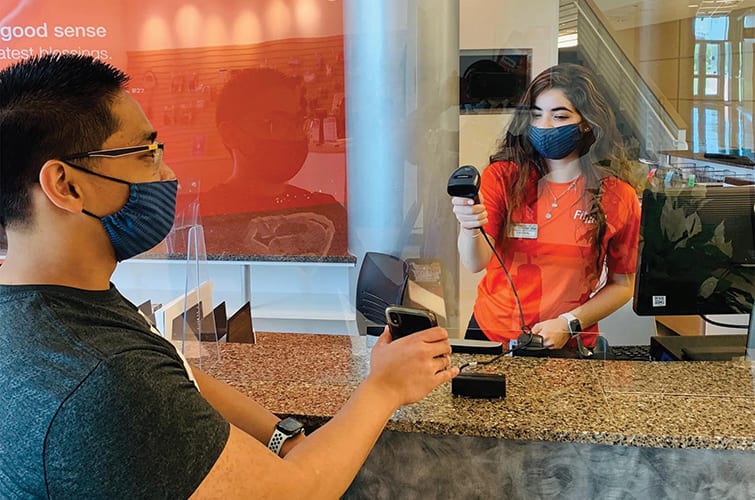
When recruiting for CENTERS staff, Brailsford said they look for several things: the team’s dynamics and what is needed, if a person is a learner, and if the potential staff member has clear standards and values.
Plus, a lot of importance is placed on retention. The CENTERS approach to developing staff involves empowering them to be effective entrepreneurs within a mutually agreed framework that is supported by an approved business plan. According to Brailsford, an entrepreneur in the CENTERS system is someone who understands how to create value in this particular context, using the department mission and purpose to inform decisions. They often must be made quickly and with the best available information, so site staff must be appropriately empowered. CENTERS ensures its site staff understand their responsibilities in this process and their committed engagement with the company’s clients to optimize all available resources to produce quality programs and services. The Program of Innovation and the Career Pathways Program are just two resources utilized by CENTERS teams to stay focused, informed and on track.
There are several benefits to the Career Pathways Program at CENTERS. “Talent and ambition are fundamental — yet every individual’s interests and circumstances differ,” said Dunlavey. “As a result, a one-size-fits-all approach to professional development would not align with our commitment to helping our people achieve their full potential and, in turn, support our growth objectives.”
Beyond culture and the right people in the right place, the ability of CENTERS to serve its clients in a tailored way hasn’t gone unnoticed. “Our discipline and commitment to grow our business exclusively in the higher education market is directly tied to a high level of respect that we have earned from our clients and employees,” said Sessine. “This is shown by our long-standing contracts and high employee retention rate over the past 20 years.”
But what really matters to CENTERS is the impact it’s making on the industry and its professionals. In fact, Brailsford said it best: the company was built in response to the question, “If you could change one thing about the campus recreation industry, what would it be?”
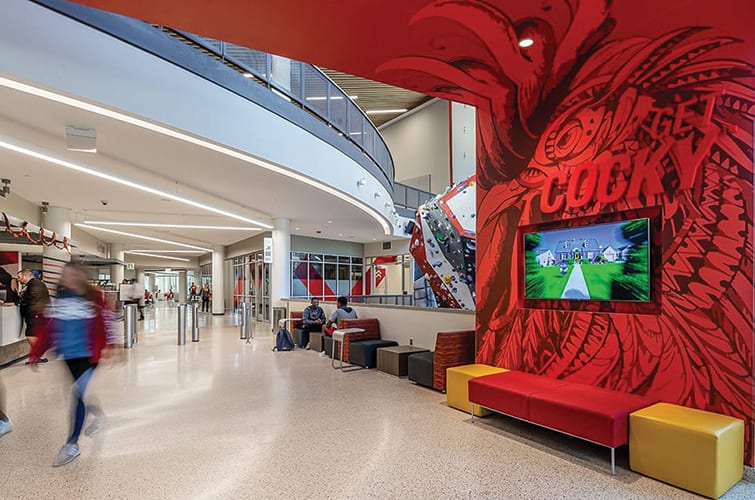
CENTERS believes campus recreation has the potential to impact the greatest portion of the campus population. And in order to do that, it needs a high-performing team with access to resources and a drive to reach for what is excellent.
“It should be staffed and led by the finest, most talented and most ambitious professionals, and should be the place where students confront their boundaries and limitations and learn how to take the risks and expend the efforts required to grow through and past them,” said Brailsford. “To achieve those outcomes, campus recreation as an industry must achieve a culture of commitment and excellence. Unwilling to wait on the entire industry, we decided to build CENTERS and drive the industry toward its destiny.”
Managed Facilities
- Cleveland State University
- DePaul University
- Harper College
- Jacksonville State University
- Marshall University
- Moraine Valley Community College
- West Virginia University at Mylan Park
- University of Alabama at Birmingham
- University of Missouri–St. Louis
- University of New Haven





